Bobak marmot
| Bobak marmot | |
|---|---|
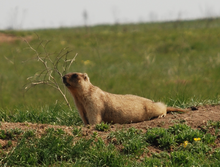 | |
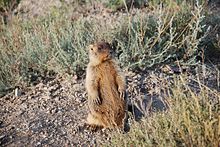 | |
| above in Ukraine, below in Volgograd Oblast, Russia | |
Conservation status | |
| Scientific classification | |
| Domain: | Eukaryota |
| Kingdom: | Animalia |
| Phylum: | Chordata |
| Class: | Mammalia |
| Order: | Rodentia |
| Family: | Sciuridae |
| Genus: | Marmota |
| Species: | M. bobak |
| Binomial name | |
| Marmota bobak (Müller, 1776) | |
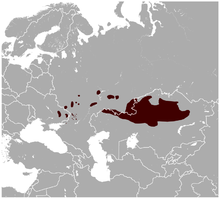 | |
| Bobak marmot range.[1] | |
The bobak marmot (Marmota bobak), also known as the steppe marmot, is a species of marmot that inhabits the steppes of Eastern Europe and Central Asia. It is a social animal and inhabits steppe grassland, including cultivated field borders. It hibernates for more than half the year. Litter sizes average about five offspring and it takes three years for the young marmots to reach sexual maturity. Male offspring leave the home colony after their second winter, and about 60% of mature females give birth in any one year.
Taxonomy
There are two recognized subspecies:[2][3]
- M. b. bobak — western part of range
- M. b. tschaganensis (alternatively shaganensis) — eastern part of range
Although western animals are larger and darker than eastern, their separation into subspecies is questionable, as the variation appears to be clinal.[3]
In the past, the other relatively short-furred and short-tailed marmots of the Palearctic region, i.e. Himalayan, Tarbagan, gray and forest-steppe, all were regarded as subspecies of the bobak marmot.[3] Today they are consistently recognized as separate from the bobak marmot.[2] Genetic studies have shown that the bobak marmot forms a species group with the gray and forest-steppe marmots, while the Himalayan and Tarbagan marmots are more distantly related.[3]
Distribution
The bobak marmot is native to the steppes of Eastern Europe and Central Asia, ranging from central and eastern Ukraine, through far southwestern Russia, to northern and central Kazakhstan.[3][2][1] Historically, its range was continuous, but it has disappeared from several regions, including its past range in southeastern Belarus and eastern Hungary, making its overall range discontinuous.[3] In some places it has been reintroduced and is slowly expanding its range again.[3] In Kazakhstan's highlands the bobak marmot comes into contact with the gray marmot and animals tend to show intermediate features.[3] Scientists Alyona Koshkina, Johannes Kamp, et al. used satellite imagery to map the location of 7,000 Bobak marmot burrows across Kazakhstan's steppes in 2019, which are home to approximately six million marmots. [4][5]
Ecology
The bobak marmot is often described as a large analog of the North American prairie dog, with a round stomach, stubby legs, and a short tail. Bobak marmots inhabit steppe ecosystems and prosper on rolling grasslands and on the edge of cultivated fields.[6] Active for about five and a half months each year, dispersers leave their natal social group after their second hibernation. Litter sizes average a little over five, and it takes at least three years to reach sexual maturity. About 60% of adult females breed in a given year. They have a single alarm call, but studies have demonstrated that bobak marmots call faster when they live in steep terrain and slower when they live in flatter terrain. Bobak marmots' fur is used to make hats and the occasional coat. Outside Moscow, a fur farm is experimenting with breeding bobak marmots in captivity for captive fur production.
Like other marmots, the bobak is susceptible to infection by bubonic plague. A population of bobaks living in the Ural Mountains is believed to have served as a reservoir host for the bubonic plague epidemic that struck western Russia at the end of the 19th century.
Marmots are preyed upon by snow leopards. They can also act as a buffer against other prey of the snow leopard.[7]
Cultural references
The bobak marmot is a symbol of Luhansk Oblast, Ukraine, as is found on its coat of arms and on the coats of arms of some of its districts.
Bobak is on the flag and c.o.a of Bizhbulyaksky District, Bashkortostan, Russia and on the c.o.a. of Kupiansk, Ukraine.
-
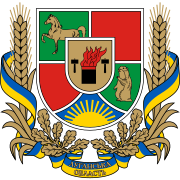 Luhansk Oblast c.o.a
Luhansk Oblast c.o.a -
 Bizhbulyak District c.o.a.
Bizhbulyak District c.o.a. -
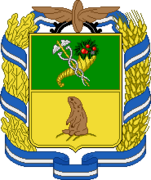 Kupiansk c.o.a.
Kupiansk c.o.a.
See also
References
- ^ a b c Tsytsulina, K.; Zagorodynuk, I.; Formozov, N. & Sheftel, B. (2017) [errata version of 2016 assessment]. "Marmota bobak". IUCN Red List of Threatened Species. 2016: e.T12830A115106780. doi:10.2305/IUCN.UK.2016-3.RLTS.T12830A22258375.en. Retrieved 14 December 2023.
- ^ a b c Grubb, P. (2005). Wilson, D. E.; Reeder, D. M. (eds.). Mammal Species of the World: A Taxonomic and Geographic Reference (3rd ed.). Baltimore, MD: Johns Hopkins University Press. ISBN 0-8018-8221-4. OCLC 62265494.
- ^ a b c d e f g h Kryštufek, B.; B. Vohralík (2013). "Taxonomic revision of the Palaearctic rodents (Rodentia). Part 2. Sciuridae: Urocitellus, Marmota and Sciurotamias". Lynx, N. S. (Praha). 44: 27–138.
- ^ Baraniuk, Chris. "How the Soviet Union's end sparked a grand rewilding". BBC. Retrieved 31 January 2021.
- ^ Koshkina, Alyona; Grigoryeva, Irina; Tokarsky, Viktor; Urazaliyev, Ruslan; Kuemmerle, Tobias; Hölzel, Norbert; Kamp, Johannes (16 December 2019). "Marmots from space: assessing population size and habitat use of a burrowing mammal using publicly available satellite images". Remote Sensing in Ecology and Conservation. 6 (2): 153–167. doi:10.1002/rse2.138.
- ^ Animal Diversity Web, University of Michigan, Marmota bobak
- ^ Jackson, R.; Hunter, D. O. (1996). "Snow Leopard Survey and Conservation Handbook Part III" (PDF). Snow Leopard Survey and Conservation Handbook. Seattle, Washington, & Fort Collins Science Center, Colorado, the United States of America: International Snow Leopard Trust & U.S. Geological Survey. pp. 1–55. Archived from the original (PDF) on 2011-07-28. Retrieved 2009-03-14.
- Thorington, R.W. Jr; Hoffman, R.S. (2005). "Family Sciuridae". In Wilson, D.E.; Reeder, D.M (eds.). Mammal Species of the World: A Taxonomic and Geographic Reference (3rd ed.). Johns Hopkins University Press. pp. 754–818. ISBN 978-0-8018-8221-0. OCLC 62265494.

- v
- t
- e
(antelope squirrels)
- Harris's antelope squirrel (A. harrisii)
- Espíritu Santo antelope squirrel (A. insularis)
- Texas antelope squirrel (A. interpres)
- White-tailed antelope squirrel (A. leucurus)
- San Joaquin antelope squirrel (A. nelsoni)
(golden-mantled ground squirrels)
- Golden-mantled ground squirrel (C. lateralis)
- Sierra Madre ground squirrel (C. madrensis)
- Cascade golden-mantled ground squirrel (C. saturatus)
(prairie dogs)
- Gunnison's prairie dog (C. gunnisoni)
- White-tailed prairie dog (C. leucurus)
- Black-tailed prairie dog (C. ludovicianus)
- Mexican prairie dog (C. mexicanus)
- Utah prairie dog (C. parvidens)
- Siberian chipmunk (E. sibiricus)
(little ground squirrels)
- Mexican ground squirrel (I. mexicanus)
- Rio Grande ground squirrel (I. parvidens)
- Thirteen-lined ground squirrel (I. tridecemlineatus)
(marmots)
- Bobak marmot (M. bobak)
- Alaska marmot (M. broweri)
- Black-capped marmot (M. camtschatica)
- Long-tailed marmot (M. caudata)
- Himalayan marmot (M. himalayana)
- Alpine marmot (M. marmota)
- Menzbier's marmot (M. menzbieri)
- Groundhog or woodchuck (M. monax)
- Tarbagan marmot (M. sibirica)
Subgenus Petromarmota: Hoary marmot (M. caligata) - Yellow-bellied marmot (M. flaviventris)
- Olympic marmot (M. olympus)
- Vancouver Island marmot (M. vancouverensis)
(western chipmunks)
- Tropical ground squirrel (N. adocetus)
- Ring-tailed ground squirrel (N. annulatus)
(rock squirrels)
- Baja California rock squirrel (O. atricapillus)
- California ground squirrel (O. beecheyi)
- Rock squirrel (O. variegatus)
- Franklin's ground squirrel (P. franklinii)
(Asian rock squirrels)
- Père David's rock squirrel (S. davidianus)
- Forrest's rock squirrel (S. forresti)
(Old World ground squirrels)
- Alashan ground squirrel (S. alashanicus)
- Brandt’s ground squirrel (S. brevicauda)
- European ground squirrel (S. citellus)
- Daurian ground squirrel (S. dauricus)
- Red-cheeked ground squirrel (S. erythrogenys)
- Yellow ground squirrel (S. fulvus)
- Russet ground squirrel (S. major)
- Caucasian mountain ground squirrel (S. musicus)
- Tian Shan ground squirrel (S. nilkaensis)
- Pallid ground squirrel (S. pallidicauda)
- Little ground squirrel (S. pygmaeus)
- Relict ground squirrel (S. relictus)
- Speckled ground squirrel (Spermophilus suslicus)
- Taurus ground squirrel (Spermophilus taurensis)
- Asia Minor ground squirrel (Spermophilus xanthoprymnus)
- Eastern chipmunk (T. striatus)
(Holarctic ground squirrels)
- Uinta ground squirrel (U. armatus)
- Belding's ground squirrel (U. beldingi)
- Northern Idaho ground squirrel (U. brunneus)
- Merriam's ground squirrel (U. canus)
- Columbian ground squirrel (U. columbianus)
- Wyoming ground squirrel (U. elegans)
- Southern Idaho ground squirrel (U. endemicus)
- Piute ground squirrel (U. mollis)
- Arctic ground squirrel (U. parryii)
- Richardson's ground squirrel (U. richardsonii)
- Townsend's ground squirrel (U. townsendii)
- Long-tailed ground squirrel (U. undulatus)
- Washington ground squirrel (U. washingtoni)
(pygmy ground squirrels)
- Mohave ground squirrel (X. mohavensis)
- Perote ground squirrel (X. perotensis)
- Spotted ground squirrel (X. spilosoma)
- Round-tailed ground squirrel (X. tereticaudus)













